Baoqun Yin
CA-I2P: Channel-Adaptive Registration Network with Global Optimal Selection
Jun 26, 2025Abstract:Detection-free methods typically follow a coarse-to-fine pipeline, extracting image and point cloud features for patch-level matching and refining dense pixel-to-point correspondences. However, differences in feature channel attention between images and point clouds may lead to degraded matching results, ultimately impairing registration accuracy. Furthermore, similar structures in the scene could lead to redundant correspondences in cross-modal matching. To address these issues, we propose Channel Adaptive Adjustment Module (CAA) and Global Optimal Selection Module (GOS). CAA enhances intra-modal features and suppresses cross-modal sensitivity, while GOS replaces local selection with global optimization. Experiments on RGB-D Scenes V2 and 7-Scenes demonstrate the superiority of our method, achieving state-of-the-art performance in image-to-point cloud registration.
Bridge 2D-3D: Uncertainty-aware Hierarchical Registration Network with Domain Alignment
Apr 02, 2025Abstract:The method for image-to-point cloud registration typically determines the rigid transformation using a coarse-to-fine pipeline. However, directly and uniformly matching image patches with point cloud patches may lead to focusing on incorrect noise patches during matching while ignoring key ones. Moreover, due to the significant differences between image and point cloud modalities, it may be challenging to bridge the domain gap without specific improvements in design. To address the above issues, we innovatively propose the Uncertainty-aware Hierarchical Matching Module (UHMM) and the Adversarial Modal Alignment Module (AMAM). Within the UHMM, we model the uncertainty of critical information in image patches and facilitate multi-level fusion interactions between image and point cloud features. In the AMAM, we design an adversarial approach to reduce the domain gap between image and point cloud. Extensive experiments and ablation studies on RGB-D Scene V2 and 7-Scenes benchmarks demonstrate the superiority of our method, making it a state-of-the-art approach for image-to-point cloud registration tasks.
Towards Precise Scaling Laws for Video Diffusion Transformers
Nov 25, 2024



Abstract:Achieving optimal performance of video diffusion transformers within given data and compute budget is crucial due to their high training costs. This necessitates precisely determining the optimal model size and training hyperparameters before large-scale training. While scaling laws are employed in language models to predict performance, their existence and accurate derivation in visual generation models remain underexplored. In this paper, we systematically analyze scaling laws for video diffusion transformers and confirm their presence. Moreover, we discover that, unlike language models, video diffusion models are more sensitive to learning rate and batch size, two hyperparameters often not precisely modeled. To address this, we propose a new scaling law that predicts optimal hyperparameters for any model size and compute budget. Under these optimal settings, we achieve comparable performance and reduce inference costs by 40.1% compared to conventional scaling methods, within a compute budget of 1e10 TFlops. Furthermore, we establish a more generalized and precise relationship among validation loss, any model size, and compute budget. This enables performance prediction for non-optimal model sizes, which may also be appealed under practical inference cost constraints, achieving a better trade-off.
Beyond Sight: Towards Cognitive Alignment in LVLM via Enriched Visual Knowledge
Nov 25, 2024Abstract:Does seeing always mean knowing? Large Vision-Language Models (LVLMs) integrate separately pre-trained vision and language components, often using CLIP-ViT as vision backbone. However, these models frequently encounter a core issue of "cognitive misalignment" between the vision encoder (VE) and the large language model (LLM). Specifically, the VE's representation of visual information may not fully align with LLM's cognitive framework, leading to a mismatch where visual features exceed the language model's interpretive range. To address this, we investigate how variations in VE representations influence LVLM comprehension, especially when the LLM faces VE-Unknown data-images whose ambiguous visual representations challenge the VE's interpretive precision. Accordingly, we construct a multi-granularity landmark dataset and systematically examine the impact of VE-Known and VE-Unknown data on interpretive abilities. Our results show that VE-Unknown data limits LVLM's capacity for accurate understanding, while VE-Known data, rich in distinctive features, helps reduce cognitive misalignment. Building on these insights, we propose Entity-Enhanced Cognitive Alignment (EECA), a method that employs multi-granularity supervision to generate visually enriched, well-aligned tokens that not only integrate within the LLM's embedding space but also align with the LLM's cognitive framework. This alignment markedly enhances LVLM performance in landmark recognition. Our findings underscore the challenges posed by VE-Unknown data and highlight the essential role of cognitive alignment in advancing multimodal systems.
SEA: Supervised Embedding Alignment for Token-Level Visual-Textual Integration in MLLMs
Aug 21, 2024Abstract:Multimodal Large Language Models (MLLMs) have recently demonstrated remarkable perceptual and reasoning abilities, typically comprising a Vision Encoder, an Adapter, and a Large Language Model (LLM). The adapter serves as the critical bridge between the visual and language components. However, training adapters with image-level supervision often results in significant misalignment, undermining the LLMs' capabilities and limiting the potential of Multimodal LLMs. To address this, we introduce Supervised Embedding Alignment (SEA), a token-level alignment method that leverages vision-language pre-trained models, such as CLIP, to align visual tokens with the LLM's embedding space through contrastive learning. This approach ensures a more coherent integration of visual and language representations, enhancing the performance and interpretability of multimodal LLMs while preserving their inherent capabilities. Extensive experiments show that SEA effectively improves MLLMs, particularly for smaller models, without adding extra data or inference computation. SEA also lays the groundwork for developing more general and adaptable solutions to enhance multimodal systems.
CBQ: Cross-Block Quantization for Large Language Models
Dec 13, 2023



Abstract:Post-training quantization (PTQ) has driven attention to producing efficient large language models (LLMs) with ultra-low costs. Since hand-craft quantization parameters lead to low performance in low-bit quantization, recent methods optimize the quantization parameters through block-wise reconstruction between the floating-point and quantized models. However, these methods suffer from two challenges: accumulated errors from independent one-by-one block quantization and reconstruction difficulties from extreme weight and activation outliers. To address these two challenges, we propose CBQ, a cross-block reconstruction-based PTQ method for LLMs. To reduce error accumulation, we introduce a cross-block dependency with the aid of a homologous reconstruction scheme to build the long-range dependency between adjacent multi-blocks with overlapping. To reduce reconstruction difficulty, we design a coarse-to-fine pre-processing (CFP) to truncate weight outliers and dynamically scale activation outliers before optimization, and an adaptive rounding scheme, called LoRA-Rounding, with two low-rank learnable matrixes to further rectify weight quantization errors. Extensive experiments demonstrate that: (1) CBQ pushes both activation and weight quantization to low-bit settings W4A4, W4A8, and W2A16. (2) CBQ achieves better performance than the existing state-of-the-art methods on various LLMs and benchmark datasets.
Advanced Efficient Strategy for Detection of Dark Objects Based on Spiking Network with Multi-Box Detection
Oct 10, 2023Abstract:Several deep learning algorithms have shown amazing performance for existing object detection tasks, but recognizing darker objects is the largest challenge. Moreover, those techniques struggled to detect or had a slow recognition rate, resulting in significant performance losses. As a result, an improved and accurate detection approach is required to address the above difficulty. The whole study proposes a combination of spiked and normal convolution layers as an energy-efficient and reliable object detector model. The proposed model is split into two sections. The first section is developed as a feature extractor, which utilizes pre-trained VGG16, and the second section of the proposal structure is the combination of spiked and normal Convolutional layers to detect the bounding boxes of images. We drew a pre-trained model for classifying detected objects. With state of the art Python libraries, spike layers can be trained efficiently. The proposed spike convolutional object detector (SCOD) has been evaluated on VOC and Ex-Dark datasets. SCOD reached 66.01% and 41.25% mAP for detecting 20 different objects in the VOC-12 and 12 objects in the Ex-Dark dataset. SCOD uses 14 Giga FLOPS for its forward path calculations. Experimental results indicated superior performance compared to Tiny YOLO, Spike YOLO, YOLO-LITE, Tinier YOLO and Center of loc+Xception based on mAP for the VOC dataset.
Boosting Mobile CNN Inference through Semantic Memory
Dec 05, 2021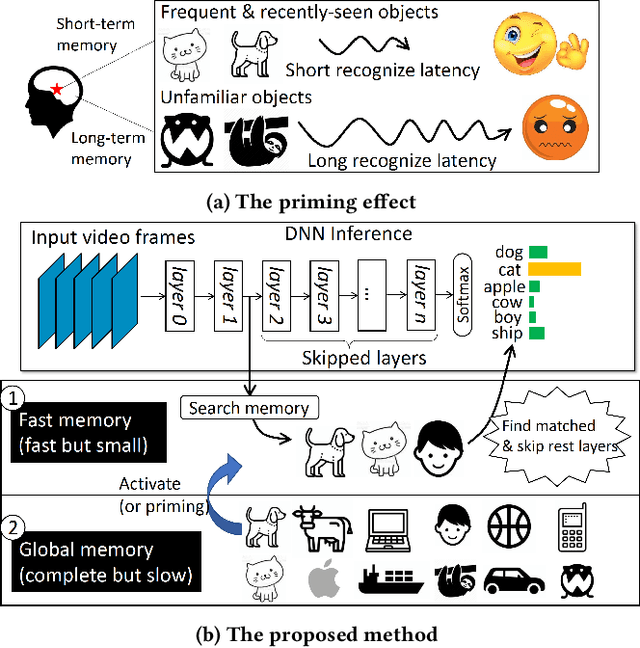
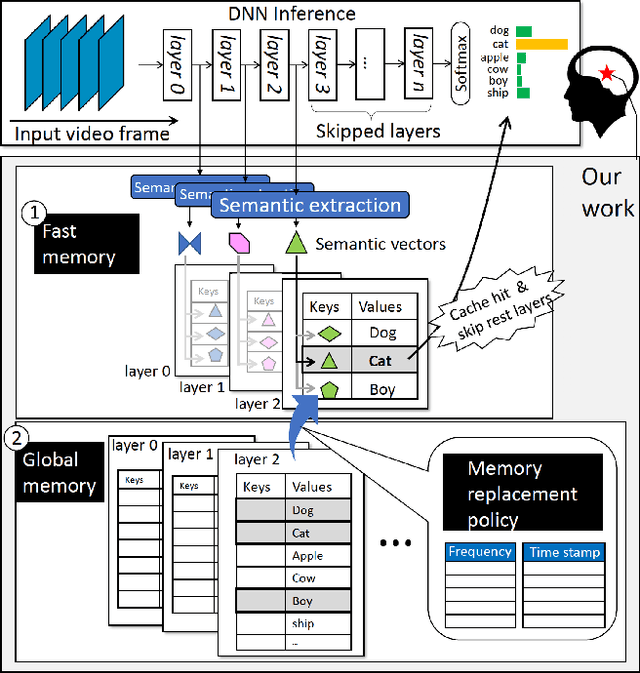
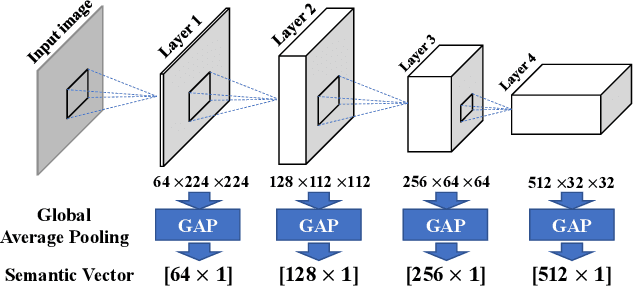

Abstract:Human brains are known to be capable of speeding up visual recognition of repeatedly presented objects through faster memory encoding and accessing procedures on activated neurons. For the first time, we borrow and distill such a capability into a semantic memory design, namely SMTM, to improve on-device CNN inference. SMTM employs a hierarchical memory architecture to leverage the long-tail distribution of objects of interest, and further incorporates several novel techniques to put it into effects: (1) it encodes high-dimensional feature maps into low-dimensional, semantic vectors for low-cost yet accurate cache and lookup; (2) it uses a novel metric in determining the exit timing considering different layers' inherent characteristics; (3) it adaptively adjusts the cache size and semantic vectors to fit the scene dynamics. SMTM is prototyped on commodity CNN engine and runs on both mobile CPU and GPU. Extensive experiments on large-scale datasets and models show that SMTM can significantly speed up the model inference over standard approach (up to 2X) and prior cache designs (up to 1.5X), with acceptable accuracy loss.
Weight-dependent Gates for Network Pruning
Jul 04, 2020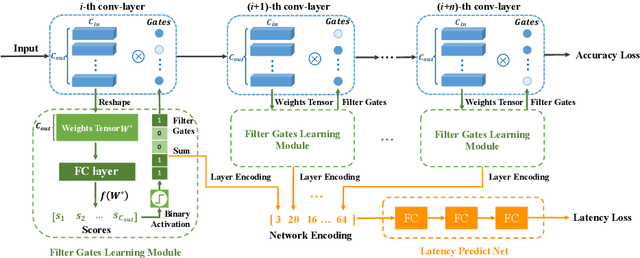
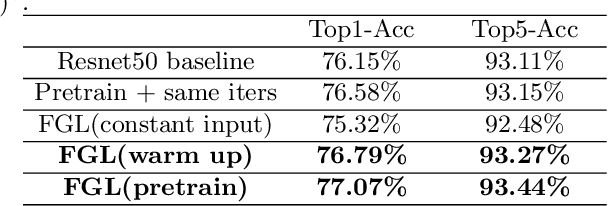
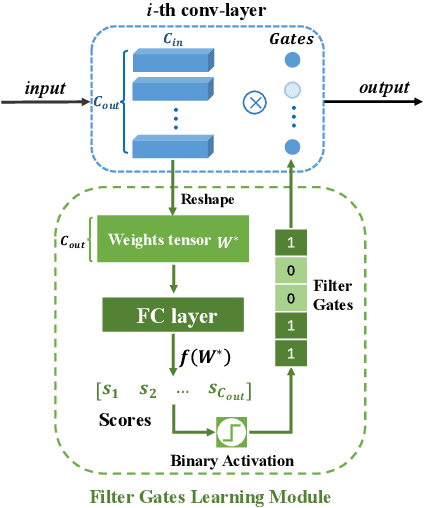
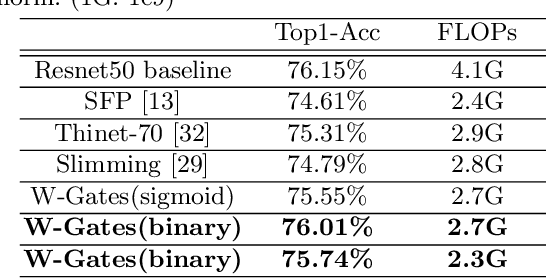
Abstract:In this paper, we propose a simple and effective network pruning framework, which introduces novel weight-dependent gates (W-Gates) to prune filter adaptively. We argue that the pruning decision should depend on the convolutional weights, in other words, it should be a learnable function of filter weights. We thus construct the Filter Gates Learning Module (FGL) to learn the information from convolutional weights and obtain binary W-Gates to prune or keep the filters automatically. To prune the network under hardware constraint, we train a Latency Predict Net (LPNet) to estimate the hardware latency of candidate pruned networks. Based on the proposed LPNet, we can optimize W-Gates and the pruning ratio of each layer under latency constraint. The whole framework is differentiable and can be optimized by gradient-based method to achieve a compact network with better trade-off between accuracy and efficiency. We have demonstrated the effectiveness of our method on Resnet34, Resnet50 and MobileNet V2, achieving up to 1.33/1.28/1.1 higher Top-1 accuracy with lower hardware latency on ImageNet. Compared with state-of-the-art pruning methods, our method achieves superior performance.
 Add to Chrome
Add to Chrome Add to Firefox
Add to Firefox Add to Edge
Add to Edge